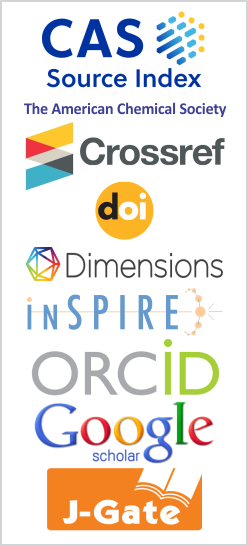Ionization of P Atom, P\(_2\) and PX (X = H, C, N, O) Molecules by Electron Impact: Theoretical Studies
DOI:
https://doi.org/10.26713/jamcnp.v5i3.1131Keywords:
Phosphorus, Electron impact ionization, Complex potentialAbstract
Being a biogenic element atomic Phosphorus is one of the significant constituents of the universe [1]. Gulick [2] found a pivotal role of phosphorus in the origin of life. The phosphoruscontaining molecules like PH, PC and PN radicals, have been observed in interstellar gas clouds [3–5] and they are proposed to be present under appropriate conditions. Phosphorous hydrides having numerous applications, are detected in cool stellar atmosphere [6] and circumstellar envelopes. Thus, the present paper addresses the electron impact processes of atomic phosphorus and its diatomic compounds. Ground and metastable states of Atomic P give rise to the probability of presence of metastable state in the atomic beam used for cross section measurement [7]. We have employed the well-known Spherical Complex Optical Potential (SCOP) formalism to calculate total inelastic cross sections. The semi-empirical CSP-ic method is used to extract total ionization cross section \(Q_{ion}\) from total inelastic cross section [8]. A variant CSP-ic approach is also attempted for these targets.Downloads
References
E. Macia, Chem. Soc. Rev. 34 (2005), 691, DOI: 10.1039/B416855K.
A. Gulick, Am. Sci. 43 (1955), 479.
B. E. Turner, T. Tsuji, J. Bally, M. Guelin and J. Cernicharo, Astrophys. J. 365 (1990), 569, DOI: 10.1086/169511.
D. D. S. MacKay, S. B. Charnley, Mon. Not. R. Astron. Soc. 325 (2001), 545.
S. N. Milam, D. T. Halfen, E. D. Tenenbaum, A. J. Apponi, N. J. Woolf and L. M. Ziurys, Astrophys. J. 684 (2008), 618.
H. R. Johnson and A.J. Sauval, Astron. Astrophys., Suppl. Ser. 49 (1982), 77.
R. S. Freund, R. C. Wetzel, R. J. Shul and T. R. Hayes, Phys. Rev. A 41 (1990), 3575, DOI: 10.1103/PhysRevA.41.3575.
S. Pandya, F. Shelat, K. N. Joshipura and B. Vaishnav, Int. J. Mass. Spectrom. 323 & 324 (2012), 28, DOI: 10.1016/j.ijms.2012.06.005.
S. A. Chaudhari, F. M. Joshi and K. N. Joshipura, Prajñ¯a 22 & 23 (2015), 84.
K. N. Joshipura and N. J. Mason, Atomic Molecular Ionization by Electron Scattering: Theory and Applications, Cambridge University Press (2019).
G. Staszewska, D. W.. Schwenke and D. G. Truhlar, J. Chem. Phys. 81 (1984), 335, DOI: 10.1063/1.447310.
M. M. Fujimoto and M. T. Lee, J. Phys. B: At. Mol. Opt. Phys. 33 (2000), 4759, DOI: 10.1088/0953-4075/33/21/319.
F. Blanco and G. García, Phys. Rev. A 67 (2003), 0022701, DOI: 10.1103/PhysRevA.67.022701.
K. N. Joshipura and S. Gangopadhyay, J. Phys. B: At. Mol. Opt. Phys. 41 (2008), 215205, DOI: 10.1088/0953-4075/41/21/215205.
K. N. Joshipura, S. S. Gangopadhyay, H. N. Kothari and F. A. Shelat, Phys. Lett. A 373 (2009), 2876, DOI: 10.1016/j.physleta.2009.05.075.
K. N. Joshipura, H. N. Kothari, F. A. Shelat, P. Bhowmik and N. J. Mason, J. Phys. B: At. Mol. Opt. Phys. 43 (2010), 135207, DOI: 10.1088/0953-4075/43/13/135207.
F. A. Shelat, K. N. Joshipura, K. L. Baluja, P. Bhowmik and H. N. Kothari, Indian J. Phys. 85 (2011), 1739, DOI: 10.1007/s12648-011-0199-z.
F. Calogero, Variable Phase Approach to Potential Scattering, Academic, New York (1974).
C. J. Joachain, Quantum Collision Theory, North Holland, Amsterdam (1984).
J. E. Turner, H. G. Paretzke, R. N. Hamm, H. A. Wright and R. H. Ritchie, Radiat. Res. 92 (1982), 47, DOI: 10.2307/3575843.
J. P. Santos and F. Parente, The European Physical Journal D 47 (2008), 339, DOI: 10.1140/epjd/e2008-00063-9.
G. Monnom, P. Gaucherel and C. Paparoditis, J. Phys. (Paris) 45 (1984), 77.
M. H. F. Bettega, M. A. P. Lima and L. G. Ferreira, J. Phys. B 31 (1998), 2091, DOI: 10.1088/0953-4075/31/9/021.
G. E. Scott and K. K. Irikura, J. Chem. Theory Comput. 1 (2005), 1153, DOI: 10.1021/ct050077j.
Downloads
Published
How to Cite
Issue
Section
License
Authors who publish with this journal agree to the following terms:- Authors retain copyright and grant the journal right of first publication with the work simultaneously licensed under a CCAL that allows others to share the work with an acknowledgement of the work's authorship and initial publication in this journal.
- Authors are able to enter into separate, additional contractual arrangements for the non-exclusive distribution of the journal's published version of the work (e.g., post it to an institutional repository or publish it in a book), with an acknowledgement of its initial publication in this journal.
- Authors are permitted and encouraged to post their work online (e.g., in institutional repositories or on their website) prior to and during the submission process, as it can lead to productive exchanges, as well as earlier and greater citation of published work.




